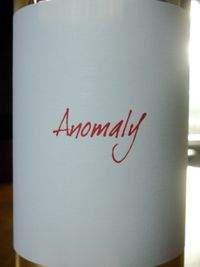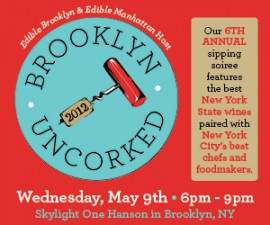Anthony Nappa Wines 2008 Anomaly
By Lenn Thompson, Publisher and Editor
When Anthony Nappa, winemaker at Shinn Estate Vineyards, interviewed for the job, he had two questions of his own for the owners, could he bring his dog to work, and could he make his own wine?
I've seen his dog at the winery myself and with the release of Anthony Nappa Wines 2008 Anomaly ($18), the second question is answered as well. His second wine, the Anthony Nappa Wines 2008 Nemesis, will be released this weeked. Both are available at Shinn's tasting room and both wines are 100% pinot noir sourced on the North Fork. The Anomaly is a white wine, while Nemesis is a more traditional pinot.
Why would he put himself through the pain of making pinot noir on Long Island, a cool, humid region? It's simple: "Part of the reason is because I love pinot, and part of the reason is
because everyone says pinot cannot be done well on Long Island. I know it can,
and I enjoy the challenge of working with such a hard grape," he says.
And when I asked him why he decided to make a white pinot, he told me that "making a white wine out of pinot gives me a pure expression of Long Island pinot noir, brought down to its basics, and allows me to better understand
the nuances of the variety grown here." Of course, he knows that it's a little off the beaten path, it's called Anomaly after all.
After tasting this wine for myself, I can say that I've found a Nappa wine I can recommend. Notice the second "p" in Nappa.
As with all the wines made at Shinn Estate, all of the fruit was hand harvested and sorted in the field. Then, it was de-stemmed but not crushed, and hand sorted on a sorting
table. The fruit was then processed by gravity, to the press, where it was very gently pressed to minimize color extraction, like a Champagne. The wine was fermented
cold, slow and aged without oak or malolactic fermentation
It is also worth noting that Anthony doesn't use enzymes or
tannins in his winemaking. He only uses a little bit of sulfur and "Some are inoculated with yeast, and
some are wild fermented, but none of the wines get DAP, only certified
organic yeast nutrients if they need them."
I didn't get a very good picture of the wine, but its nearly colorless with only the faintest suggestion of pink. Unless you're looking for it, you may not even see it.
You're reminded that this is pinot noir once its aromas greet your nose, however. Delicate aromas of wweet red cherry, strawberry and strawberry hull are accented with a light note of sweet herb way in the back that became more apparent as the wine warmed to room temperature.
On the palate, it is mouth-filling, with a beautiful silky texture (this is pinot, remember?) that delivery clean, bright red fruit flavors, framed by good acid backbone.
Producer: Anthony Nappa Wines
AVA: North Fork of Long Island
Price: $18*
Rating:
(3 out of 5 | Recommended)

















What kind of YAN are LI grapes usually pulling in? It has long been the recommendation of the Geneva extension that FL winemakers add the max amount of DAP.
Since you mentioned that he doesn’t use tannins in his wine making, I assume that means that it wouldn’t be rare that L.I. winemakers do add tannin.
I know that this may be something that most people wouldn’t like to admit, but is it common practice there?
Great questions…and as you say Bryan, not people want to admit or talk about this stuff.
Maybe Anthony will chime in when he sees this?
Sure Lenn always happy to share how our wines are made. And also to correct your post, the Nemesis Pinot Noir being released today is a 2007.
Tom, I do not know the YAN numbers for our must as I am not set up to test for it, and neither is PWG here, often times if you over ripen with long hang time or just in a hot climate like yours Nitrogen levels are much lower at harvest then in a cool climate. Not using DAP makes yeast nutrition much harder to manage and much more expensive but with a long slow ferment I believe smaller more spaced out additions of yeast derived organic nutrition leads to a slower healthier ferment then just blindly adding a bunch of chemical nitrogen at crush. But I do have a bag of DAP at the winery and if all else fails I will use it instead of losing the wine.
Instead of testing the wine we test the soil and tissue of the vines more often throughout the year which allows Barbara to be much more focused in her compost piles and Biodynamic tea drenches to deliver all the nutrition the vines need, which in turn produces fruit which are not deficient in nutrition.
Bryan, addressing tannins specifically, in this post it was mentioned as a part of what I talked with Lenn about as far as how our wines are made in general. For white wines like Anomaly tannins are not often added but some winemakers do add some types of tannin at crush to help prevent oxidation, to supplement or eliminate adding Sulfur or Ascorbic acid.
For red wines tannins are an integral part of the structure of the wine, if under ripe in a cool climate they can be harsh or green and unbalanced in the wine. If this is the case they can be stripped away from the wine and added back to the wine out of a bag. Having good tannin structure is important for balanced full bodied red wine, and when manipulated you can taste the difference, as a wine is more disjointed and un-integrated.
Tannin additions are very common around the world for factory wines from two buck chuck and yellow tail on up the spectrum. It can be a useful tool even in a warm climate to make wines all taste the same year to year using different fruit, or in a cool climate with unripe fruit.
Specifically and historically on LI I believe tannin additions are commonplace. When I moved here I even had winemakers tell me you can’t make wine on LI without adding tannin.
I choose not to because I want my wines to express their ‘place’ and be representative of our region.
Thanks for your questions and stop by to taste anytime and I can explain better.
Can you tell me how much of the Anomaly and Nemesis was produced? Also, the alcohol content. Thanks.
I am planning a trip to the Vineyards end of the August and look forward to trying.
Anthony coming from a cool climate area myself these days, I appreciate your explanation.
Do you plan on making pinot noir consistently or might you just source grapes from what looks good that year?
Yes Anomaly is 12.9% Alc and was about 160 cases and Nemesis is 13.8% Alc and was about 220 cases
Anomaly has been out for about 2 months now and is already 1/3 sold so it may be sold out by August and Nemesis was released this weekend.
Also thanks for the comments Bryan and I am hoping to find some good vineyards to work with in the future with Pinot Noir as well as other varietals, who knows what may be available and will be released next? I hope to work with a variety of things to help me understand LI better.